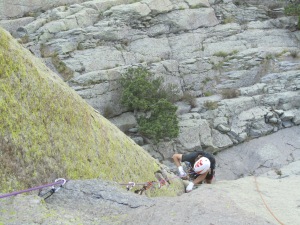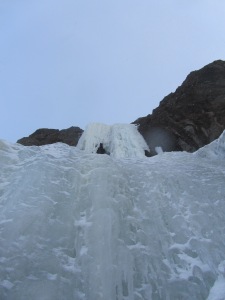Wyoming is a Banana Republic. That is, very few of its residents craft any products, or add value to pre-existing items. Instead, they survive by selling off the state bit by bit. The major industries are mineral extraction and tourism. Reliance on those commodities creates a vicious cycle, because the state’s fortunes rise and fall with mineral prices and popular whimsy. To live through the fluctuations, politicians skimp on the state budget so that they can put enough money in the bank to survive the next economic lull. A few lonely prophets call for investing those funds in economic diversification, in the interest of breaking free from the cycle of feast and famine. The politicians repeatedly acknowledge that diversification is a good idea, but can never bring themselves to actually commit to it. It is just too risky.
So, the state carries on in its bumpy ruts, booming and busting. Decades on this road have had socioeconomic consequences. The path has led to a land of Manors and mobile homes, housing those who own the mines and the lovely land and their servants respectively.
No place in the state epitomizes this case study in Marxist historical analysis better than the town of Jackson. A ring of expensive houses surrounds a ring of expensive condominiums which surrounds a cluster of expensive restaurants, galleries, and boutiques. And that is Jackson. Though Jackson is fancy enough in any season, its exclusivity shines brightest in winter. In summer, the dirtier class of tourist drives through town on its way to Yellowstone. In winter, the only reason to be in Jackson is to patronize one of the ski resorts or to serve the patrons.
Although, there is one other, statistically insignificant reason to be in Jackson in the winter. For several years, that reason compelled me. I wanted to climb the grand Teton in full conditions. There is no reasonable explanation for that compulsion. I just feel a perverse attraction to isolated, windswept places. For instance, when I topped out on California Ice in the Bighorns, I sat on a rock and looked across from Hell Roaring plateau to Froze to Death plateau and was filled with a rare sensation, a feeling of fearsome loneliness, and profound contentment along with it. I can’t offer any better excuse.
When the idea first came to me, I sought out a friend who had done a lot of climbing in the Teton range. Sure enough, he had attempted a winter ascent. He got close, but after a day of skiing through waist deep powder, he and his partner had to bivouac short of their goal. They were well prepared, but the night was so brutally cold, that they were beaten by the next morning and decided to ski down. They fell into chest deep powder on each turn. My friend’s partner lost his mind. He took his skis off and tossed them, javelin style, down the snowfield. He then swam after them over the loaded slope, cursing and spluttering, until he could get his hands on the traitorous bastards and chuck them again. Though he came back to his senses eventually, the trip marked an end to their partnership..
Despite that tale, and others warning of frostbite and avalanche, I still thought I could pull it off, and I still wanted to pull it off, maybe even more than before. It wasn’t a solo adventure though, and to my surprise and frustration, I had difficulty convincing anyone else to come along.
Finally, I persuaded my friend Jim that it would be a good adventure. I’m not sure if he ever really believed that we would climb, but he believed in the adventure part and that was good enough for him. We set up base camp at the Motel 6 down the road from the main town.
Over the next week, we made a few forays up past the tree line, but the avalanche forecasts were always bad, and the peak was socked in with clouds and blowing snow besides. Nobody said anything; we just gave up one day. We got up late, and Jim suggested that we might go up to Teton Pass and do some tele skiing.
Now it was my turn to cash in on the adventure itself rather than the intrinsic joys of the activity. I knew how skis worked, theoretically. But until that day, I had only used skis to get somewhere with a pack on. My technique was purely pragmatic, and rudimentary. To go downhill, I left the climbing skins on the skis. I then skied across the slope, stopped and turned to face the other direction. I repeated that process to the bottom of the hill.
When we got to the top of the pass, the skins came off the skis. Jim gave me some tips on turning without stopping, and then we were off. Again and again I nosedived into the unconsolidated powder. Jim was soon out of sight. I began to suspect retribution. I felt like I owed him at that point though, so I sucked it up and ate a little more snow while he carved track after track in the slope. When we had had enough, we went into town and wandered around.
Winter tourists milled around the square. Most were dressed to ski, with lift tickets still clipped to their coat zippers. A few were dressed as cowboys in Stetsons and shearling coats. The famous antler arch was busy with group after group documenting the fact of their visit to Jackson Hole with a picture under the strange sculpture of bone.
There was not much for us around the square. We stood outside a couple of the bars and debated going in for a drink. They seemed too crowded though, and we decided against. We stopped by the mountaineering shop, which at this point in its evolution had basically become a Patagonia outlet, to chat with an old friend of Jim’s. We didn’t go in to any of the other establishments, but we did stop for a while in front of a photo display. Though neither of us was in the market for an expensive print, Jim had a professional interest in the product.
Jim was a photographer, but not the kind of photographer who had a gallery in downtown Jackson Wyoming. Jim was an artist who scraped by on grants and museum patronage. He took pains to draw a distinction between what he did, and what a commercial photographer did. Yet he radiated a little glow of resentment as we stood in front of the spotless plate glass. The gallery inside was all polished wood. If there was an attendant, he or she was politely hidden in the back.
The well lit pictures were all of wildlife. Most depicted charismatic megafauna. The photographer seemed particularly fond of bears. Jim glanced over most of these offerings in a second, and then paused for a bit in front of a family of polar bears. He wore a discomforted expression.
“What do you think?”, I asked.
I expected to catch him off guard, and I was halfway teasing with the question, but he shot back right away.
“It’s too didactic”
I was caught off guard.
“What do you mean by that?”, I asked.
“It looks like a photograph,” he said.
I didn’t exactly know what he meant. However, I could see that there was something different about the pictures of wildlife in that gallery, and his pictures. There was one photo of his in particular, taken at Lac Du Flambeau, which stood out to me. The subjects were two members of the tribe, a man and a woman. He was looking into the distance with an expression of anger or determination, it was hard to say which. She stood behind him, maybe in contact with him, wearing that same, mysterious expression, but she was looking at him. She was standing still. He appeared prepared to stride off towards whatever it was the distance. He was silent. She was speaking.
Clearly, his photo was something other than the picture of the polar bear family. I understood the gist of it then, but it would be years before I could put that distinction into words. It is the difference between pictures of polar bears, and polar bear pictures. Pictures of polar bears could be pictures of the whole bear, but also could be photos of a patch of fur, a black nose, or a white dot in the distance. Polar bear pictures could depict whole bears too, but include stick figures, polar bear paintings, pictures of men in polar bear suits, or black eyes, a black nose and a red mouth on white canvases.
Pictures of polar bears document. Polar bear pictures represent. By representing, polar bear pictures evoke all the relative connections which comprise our categories, and therefore the sense of our experience.
The picture in the gallery was a picture of polar bears. It was as documentary as the tourists’ snapshots under the antler arch. The photograph of the man and woman at Lac Du Flambeau was representational. There was something about human relationship, emotion, and the interpretation of expressions in the photo. But the really brilliant thing was: the photo primarily represented something not present in the image itself.
The predominant impression was the churn of excitement and uncertainty which occurred in the beholder. It was a class of sensation which bound subsequent viewers to the original viewer in its momentary intensity.
Jim has been gone for some years now. I can’t even find that picture in the supposed eternity of the Internet. I don’t need to, because I can remember it in every detail by the feeling it represents. The feeling is the same as my excuse for wanting to climb the Grand in winter, and I think it also explains why Jim would throw in on my crazy project.
There is no gallery for such things.







































